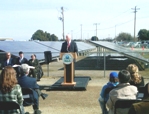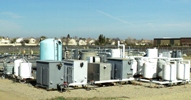
Solar Power Cuts 120 Years off Superfund Site Cleanup
Partners used stimulus funding to expand solar panels that run electrical resistance heating system to clean up groundwater at the Frontier Fertilizer Superfund site.
The U.S. Environmental Protection Agency’s Jared Blumenfeld, U.S. Rep. Mike Thompson, and Linda Adams, secretary of the California Environmental Protection Agency, on Feb. 23 provided details about recent energy conservation and cleanup accomplishments at the Frontier Fertilizer Superfund site in Davis, Calif., according to an EPA press release.
An innovative electrical resistance heating system partially funded by the American Recovery and Reinvestment Act officially went online and will reduce the projected timeline to cleanup the site from 150 years to 30 years.
“For the first time ever, solar will provide all of the power for a Superfund groundwater cleanup,” said Blumenfeld, regional administrator for the Pacific Southwest. “Our goal should be to clean the environment in the greenest way possible — and this new treatment plant sets the benchmark for future actions.”
More than $2.5 million in stimulus funding has gone to recent improvements at the site. By installing the solar panels and starting the new system, the site will lower overall energy costs by $15,000 a year and reduce carbon dioxide emissions by more than 54 metric tons a year.

Electrical resistive heating is sometimes used to clean up sites when conventional methods will not work. The heating system includes 236 heating electrodes that will heat the soil and groundwater to the boiling point of water. Extraction wells strategically located in and around the heated areas collect gas and liquids generated by the heating system. Extracted gas and liquids are treated with granular activated carbon. Twenty-seven temperature-monitoring wells will be used to monitor the below-ground operation.
EPA first installed limited solar panels at the Frontier site in 2007. The initial system helped to partially offset the electrical power needs for the groundwater treatment system but could not fully power the site. In 2010, $350,000 in Recovery Act Funds were used to expand the solar system, which now provides 100 percent of the power for the groundwater treatment system.
The new solar panels cover half an acre and will off-set non-renewable energy use. The expanded solar panel system was installed by a small, local business. To further green the site, the project team is also evaluating options for the reuse of treated groundwater for irrigation of cty and Caltrans properties.
The Frontier Fertilizer site was first developed in the 1950s to store agricultural equipment. Operations in the 1970s and 1980s consisted of storing, mixing, and delivering pesticides and herbicides. For years since, toxic chemicals including pesticides and herbicides have been leaking into soil and groundwater, the primary source of drinking water in the area.
The eight-acre site is located near the eastern city limit boundary line in the city of Davis. The Barber and Rowland Company operated a pesticide and fertilizer distribution facility on the Site from 1972 to 1982. The Frontier Fertilizer Company used the Site from 1982 to 1987. Both companies used a 4,000-cubic-foot former disposal basin in the northwest corner of the site to dispose of unused pesticides and fertilizers. Returned tanks and containers were washed and the rinsate was dumped into the disposal basin or onto the ground. In 1985, Frontier Fertilizer excavated approximately 1,100 cubic yards of contaminated soil from the former disposal basin and land farmed the soil on a field east of the site. In 2000, all structures, above-ground tanks, and underground tanks were removed with the exception of a warehouse that contains the groundwater treatment system.
There are four water-bearing zones beneath the site, which are generally separated by layers of clay. About 180 feet below ground surface is the source of the city's drinking water supply. No site contaminants above drinking water standards have been detected in the aquifer but the potential for migration exists.
This Superfund Cleanup is a partnership between the California Department of Toxic Substances Control, Regional Water Quality Control Board and the Frontier Fertilizer Superfund Oversight Group.
Source: EPA